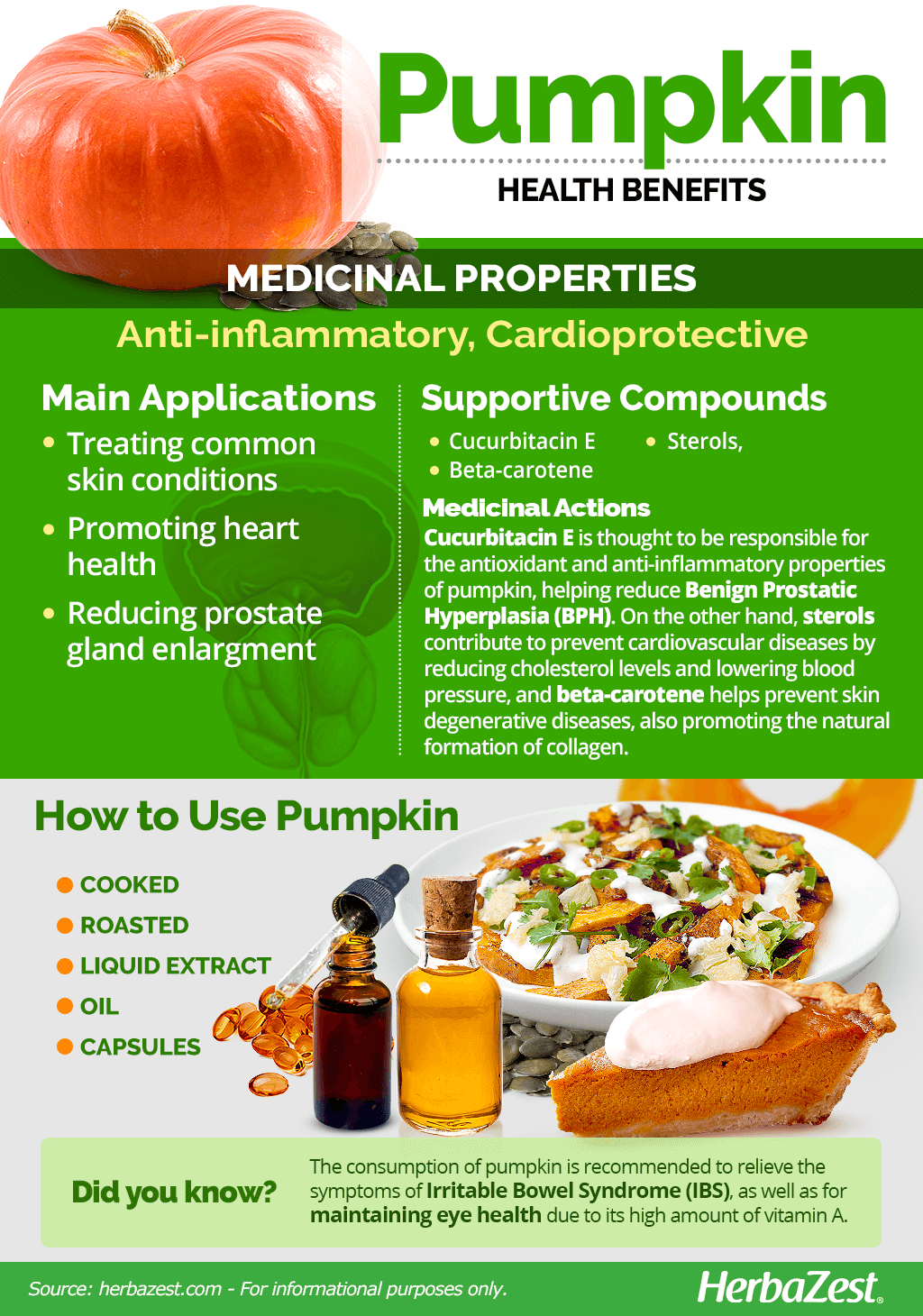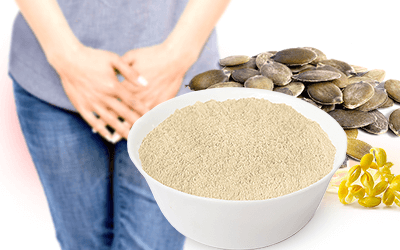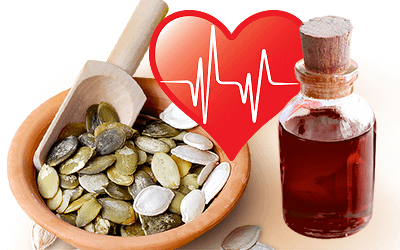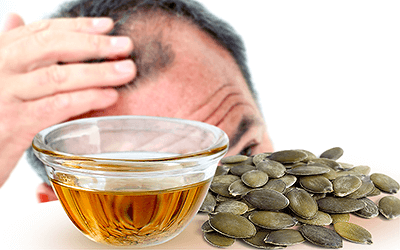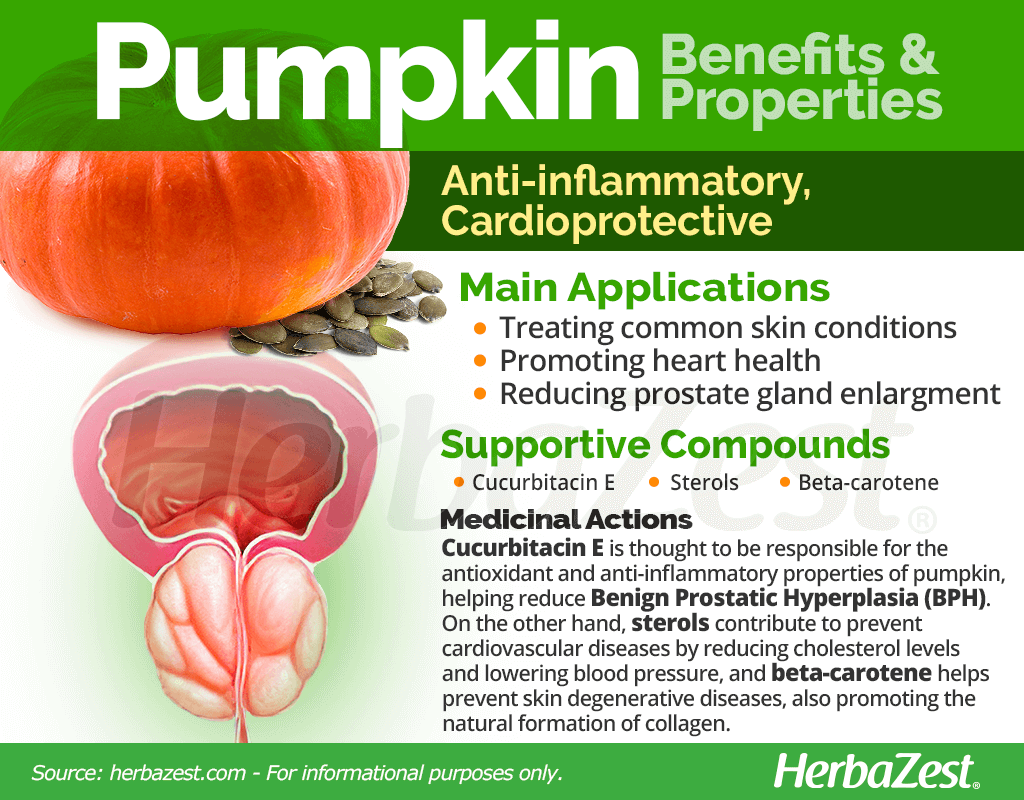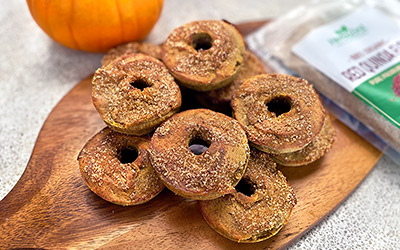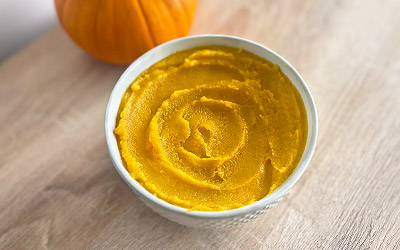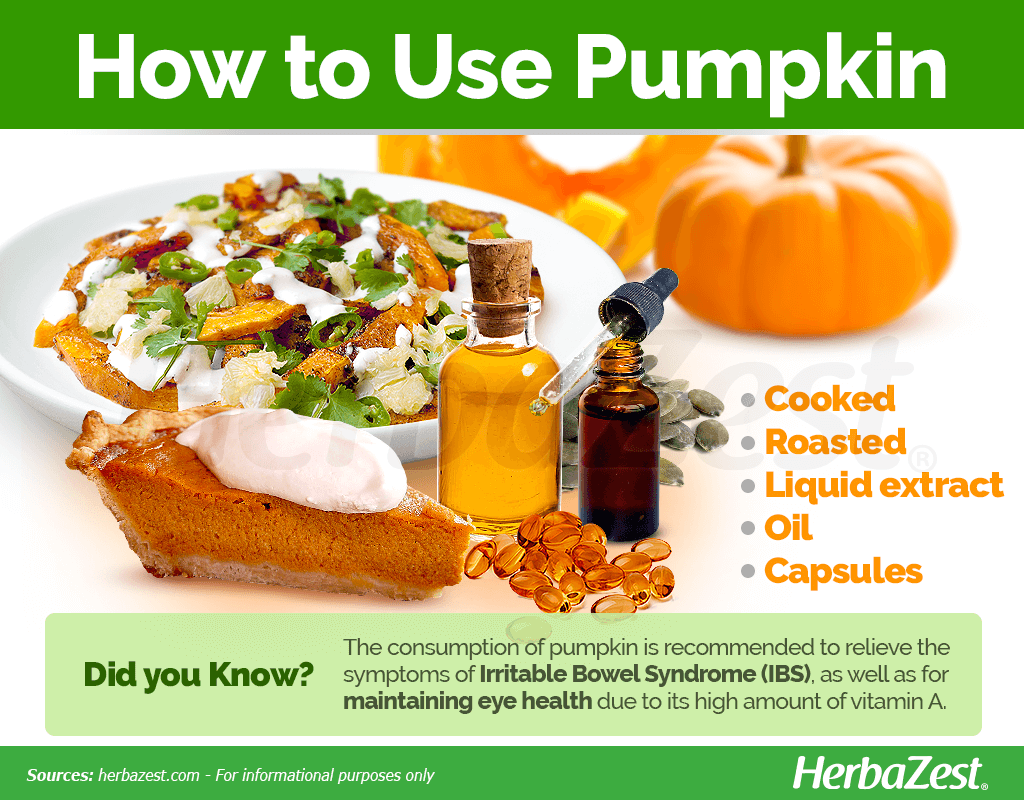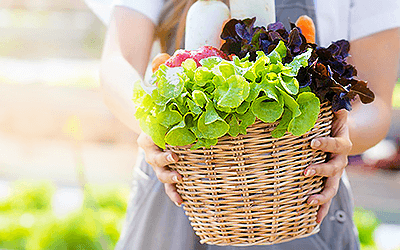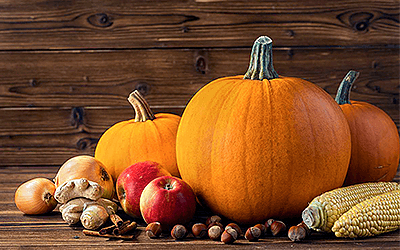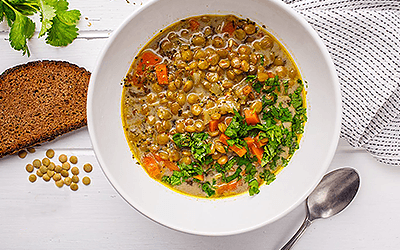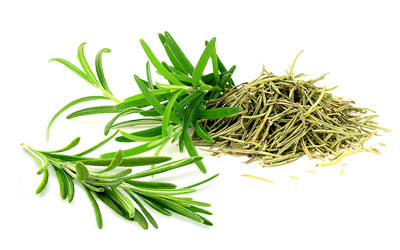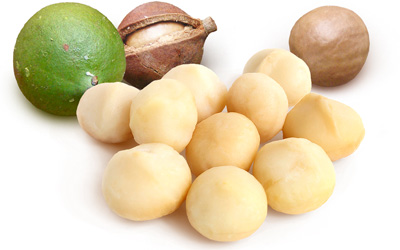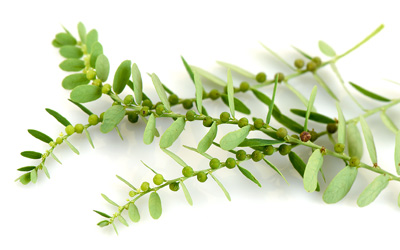The pumpkin plant, thought to originate from North and Central America, has been used for its medicinal and nutritious benefits for centuries. Nowadays, pumpkin is most commonly associated with Autumn celebrations. The carved pumpkins are Halloween's signature decorations, and the pumpkin pie is arguably the most traditional Thanksgiving dessert. Keep reading to learn more about the medicinal benefits, botanical characteristics, history, and many uses of this versatile fruit.
Pumpkin Medicinal Properties
- Medicinal action Anti-inflammatory, Cardioprotective
- Key constituents Cucurbitacin E, sterols, beta-carotene
- Ways to use Capsules, Liquid extracts, Food, Essential oil, Dried
- Medicinal rating (2) Minorly useful plant
- Safety ranking Safe
Health Benefits of Pumpkin
The antioxidant and anti-inflammatory characteristics have given pumpkin many traditional medicinal uses, mainly:
- Reducing prostate gland enlargement. Pumpkin seeds have been shown to reduce symptoms of benign prostatic hyperplasia, thus improving aging men's quality of life.1
- Regulating blood sugar levels. Studies have shown that pumpkin seeds can lower blood sugar levels by delaying carbohydrate absorption.2
Treating common skin conditions. Pumpkin has been traditionally used to treat burns, sores, and blisters, as well as for healing wounds.
Promoting heart health. Because of their richness in omega-3 fatty acids, they contribute to keeping cholesterol levels in check. Also, a study has found that pumpkins help manage high blood pressure in postmenopausal women.3
Additionally, the vegetable is also recommended to relieve the symptoms of Irritable Bowel Syndrome (IBS). Initial studies have also revealed the beneficial effects of pumpkin on inducing sleep, while another trial has shown that pumpkin seed oil may benefit men with androgenetic alopecia.4,5
How It Works
The cucurbitacin in pumpkin seeds also helps repel intestinal worms.
A major compound in pumpkin is cucurbitacin E, a triterpene with strong antioxidant and anti-inflammatory properties. It is mainly contained in the seeds and has been shown to inhibit cyclooxygenase-2, an inflammatory protein related to a number of health conditions, including Benign Prostatic Hyperplasia (BPH).
Other powerful anti-inflammatory compounds in pumpkin are selenium, Omega-3 fatty acids, and sterols, all of which also contribute to prevent cardiovascular diseases by reducing cholesterol levels and lowering blood pressure.
With its high levels of beta-carotene pumpkin offers protection against many diseases, as well as many of the degenerative aspects of aging, including skin damage and eyes health. Beta-carotene not only has a strong photo-protective action that helps prevent the damage caused by ultra violet radiation, but it also promote the natural formation of collagen.
Pumpkins are also rich in potassium, fiber, and vitamin C, and therefore help promote healthy heart and kidney function.
Peppermint and cardamon also help reduce inflammation, and similar cardioprotective benefits can be found in herbs like olive and quinoa.
Pumpkin Side Effects
No side effects or drug interactions have been reported regarding to regular consumption or proper therapeutic doses of pumpkin (Cucurbita pepo). However, the over-consumption of bitter-tasting squashes - with higher levels of cucurbitacin - may cause diarrhea and dehydration.
Pumpkin Nutrition
Pumpkin is not only low in calories and carbohydrates, but also provides good amounts of essential minerals, such as potassium, necessary for the optimal functioning of muscles, including cardiac and lung muscles. Potassium is also an electrolyte that regulates the balance of fluids within the body, closely interacting with sodium in order to maintain adequate blood pressure and pH as well as controlling nerve impulses.
Pumpkin also contains copper, a trace mineral that aids iron absorption. It is essential for the production and transport of blood cells as well as for maintaining healthy bones, blood vessels, nerves, and immune system.
However, the flesh of pumpkin is better known for being a great source of vitamin A (from beta-carotene). Vitamin A is essential for skin regeneration and strong bones, also promoting good eye health and preventing age-related degenerative diseases.
Additionally, the pumpkin fruit provides adequate amounts of vitamins C (ascorbic acid), B2 (riboflavin), and E (alpha-tocopherol) as well as small amounts of other minerals, such as iron, magnesium, and zinc.
100 grams of cooked pumpkin provide 20 calories, with 2% and 4% of the daily value for carbohydrates and dietary fiber, respectively.
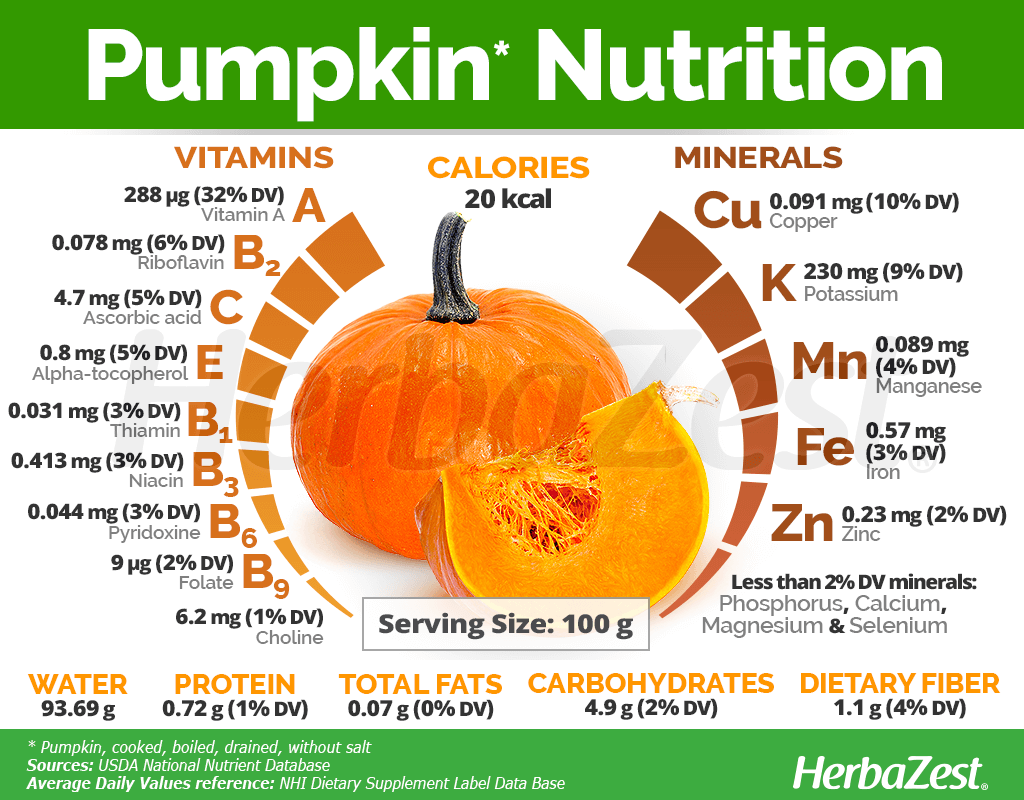
How to Consume Pumpkin
- Edible parts Flowers, Fruit, Seed
- Edible uses Oil
- Taste Sweet, Mild
There are many ways to incorporate pumpkin into a healthy diet. Most usually consumed as food, pumpkin can also be found as a supplement, which concentrates its medicinal benefits.
it is possible to dehydrate the fruit for long term storage, or buy it canned.
Natural Forms
Cooked. The soft texture and mildly sweet taste of pumpkins makes them a popular ingredient in many dishes, from soups to flans to breads. Pumpkin flesh is rich in beta-carotene and have anti-inflammatory properties.
Roasted. Traditionally, pumpkin seeds have been roasted and consumed as a snack. In this form, pumpkin seeds can help reduce cholesterol and blood pressure levels, as well as boost cardiovascular health.
Herbal Remedies & Supplements
Liquid extract. Pumpkin seed extract may also be combined with cranberries in some supplements for the purported benefit of improving urinary tract health.
Oil. The cold pressed seeds of pumpkin produce an omega-3-rich oil that can be consumed every day in order to prevent cardiovascular diseases.
Capsules. For medicinal purposes, capsules containing pumpkin seed oil are available.
Growing
- Life cycle Annual
- Harvested parts Seeds, Fruit
- Light requirements Full sun
- Soil Well-drained
- Soil pH 5.6 – 6.0 (Moderately acidic), 6.1 – 6.5 (Slightly acidic)
- Growing habitat Temperate climates
- Planting time Right after last frost
- Potential insect pests Aphids, Mites, Cucumber beetles, Squash bugs, Whiteflies
- Potential diseases Root rot
Available in a wide range of sizes and shapes, pumpkin can be easily cultivated in a home garden. However, it should be kept in mind that the vines need room to spread out up to 15 feet (4.5 m).
Pumpkins need to receive full sun and good drainage for optimum growth; with too much water, root rot could occur.
Pumpkins grow best in moderately to slightly acidic soil.
The ideal temperature for germination is be between 77 - 86°F (25 - 30°C) and the seeds should be planted after the last frost.
Pumpkin seeds should be sown about two inches (5 cm) deep, roughly in the center of where the vines are expected to spread.
The plants should be watered deeply but not too often.
More detailed information about growing pumpkin can be found in the herb garden section.
Additional Information
- Other uses Cosmetics
Plant Biology
The pumpkin plant can bear a fruit of up to 66 pounds (30 kg), which can be anything from spherical to very long in shape. The fruit is normally orange in color, but other colors are possible. As well as the edible fruit, the plant also produces attractive yellow flowers and lobed leaves, which grow on its twining stems.
Classification
Pumpkin, or Cucurbita pepo, is a member of the Cucurbitaceae family; which comprises about 990 species, including cucumber and melon. The genus Cucurbita, exclusive from the New World, includes over 27 species, including a variety of squashes, gourds, and pumpkins.
Varieties and Subspecies of Pumpkin
The three recognized subspecies of Cucurbita pepo are C. pepo subsp. fraterna, subsp. pepo, and subsp. texana. Within these, there are countless varieties and cultivars, many of which have been manmade and some of which have developed in the wild. The most commonly cultivated subspecies is pepo.
Historical Information
The origin of pumpkin is obscure and there is some debate, although it is generally thought to hail from somewhere in the Americas.
PUMPKIN IS THOUGHT TO BE ONE OF NORTH AMERICA'S MOST ANCIENT DOMESTICATED PLANTS, WITH THE OLDEST KNOWN LOCATIONS IN MEXICO CLOCKING IN AT ABOUT 10,000 YEARS AGO.
Archaeological evidence suggests that the Aztecs used to snack on pumpkin seeds, meaning their nutritious benefits have been of historical importance as well as their medicinal properties. Historically, it has played an important role in healthcare. The Mayans applied the sap to burns, the Menominee people recognized and used the seeds for their diuretic properties, and European settlers created an effective worming remedy, by mixing the seeds with water, milk, or honey.
Economic Data
Today, the pumpkin is commonly associated with jack-o'-lanterns and the Halloween holiday, but it is also widely used as a culinary ingredient. China is the world's leading producer of pumpkins and squashes with seven million tonnes per year, and worldwide, a massive two million hectares of land is dedicated to growing them.
Other uses
Decoration. Because of the tough outside and soft inside, pumpkins can easily be scooped out and carved into the exterior, creating jack-o'-lanterns to celebrate Halloween.
Personal care. Additionally, both extract and essential oil of pumpkin seeds boast emollient and antioxidant properties, and are used in the cosmetic industry as ingredients for facial moisturizers, hair conditioners, shampoos, lip balms, foundations, and anti-aging treatments.
Sources
- Dermato-Endocrinology, Discovering the link between nutrition and skin aging, 2012
- Handbook of Medicinal Herbs, Second Edition, p. 595
- Oregon Health & Science University, Toxic Squash Syndrome: A case series of diarrheal illness following ingestion of bitter squash, 1999–2011
- The Environmental Working Group, Skin Deep, Cucurbita Pepo (Pumpkin) Seed Extract, Cucurbita Pepo (Pumpkin) Seed Oil
- The FACEB Journal, Isolation of cucurbitacin E from pumpkin seed and analysis of its anti-cancer and anti-inflammatory activities, 2008
- Theoretical and Applied Genetics, Genetic relationships and evolution in Cucurbita pepo (pumpkin, squash, gourd) as revealed by simple sequence repeat polymorphisms, 2011
- University of Illinois, Pumpkin Nutrition
- USDA Plants Database, Cucurbita pepo L. var. pepo field pumpkin
- Encyclopedia of Herbal Medicine, p. 196
- FAOSTAT, Pumpkin
- The Herbal Kitchen, p. 212
- Power Foods
Footnotes:
- Journal of Medicinal Food. (2019). Effects of an Oil-Free Hydroethanolic Pumpkin Seed Extract on Symptom Frequency and Severity in Men with Benign Prostatic Hyperplasia: A Pilot Study in Humans. Retrieved December 18, 2020 from https://pubmed.ncbi.nlm.nih.gov/31017505/
- Nutrition Research. (2018). Addition of pooled pumpkin seed to mixed meals reduced postprandial glycemia: a randomized placebo-controlled clinical trial. Retrieved December 18, 2020 from https://pubmed.ncbi.nlm.nih.gov/30055778/
- Complementary Therapies in Clinical Practice. (2019). The effects of pumpkin seed oil supplementation on arterial hemodynamics, stiffness and cardiac autonomic function in postmenopausal women. Retrieved January 13, 2020 from https://www.sciencedirect.com/science/article/abs/pii/S1744388119304864
- Journal of Pharmacy & Pharmacognosy Research. (2019). Efficacy of pumpkin oil (a Persian medicine product) in the treatment of chronic insomnia: A randomized double-blind clinical trial. Retrieved December 18, 2020 from https://jppres.com/jppres/efficacy-of-pumpkin-oil-for-insomnia/
- Evidence-based Complementary and Alternative Medicine. (2014). Effect of Pumpkin Seed Oil on Hair Growth in Men with Androgenetic Alopecia: A Randomized, Double-Blind, Placebo-Controlled Trial. Retrieved December 18, 2020 from https://www.ncbi.nlm.nih.gov/pmc/articles/PMC4017725/
